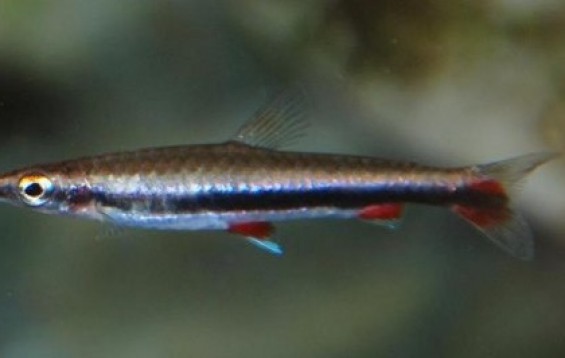- Name:
Blackstripe pencilfish
- Family: Lebiasinidae
- Species: Pencil Fish
- Scientific Name: Nannostomus harrisoni


General info about Blackstripe pencilfish
These fish are silver with a dark horizontal stripe that goes from the nose to the caudal peduncle, also, the base of the tail fin and the anal and ventral fins are red. They can reach up to 2.5 inches and are extremely slender. To keep these fish in captivity, water pH should be between 5.5 and 7.0 and water temperature should range from 74°F to 82°F. The tank should have plants and floating vegetation. They are peaceful, however, they are not recommended for a community aquarium due to their small size unless the community is composed of equally small fish, also, they should be kept in groups of 10 or more.
Blackstripe pencilfish Diet & Nutrition
This species is omnivorous. In the wild it feeds on invertebrates and zooplankton. In captivity it can be fed with dried foods and live foods like Artemia and worms.
Determining Sex of Blackstripe pencilfish
Males have a red coloration on their fins and are thinner than the females.
Breeding & Spawning Blackstripe pencilfish
To breed this species in captivity, the breeding tank should be heavily planted. The eggs are laid and fertilized in the plants.
Blackstripe pencilfish Origin
This species is native to Guyana. It inhabits slow moving tributaries and small rivers that are densely vegetated.
Acclimating Blackstripe pencilfish
The water in which these fish are packaged is different from the water in the tank, since these fish are extremely sensitive to water conditions the acclimation process is very important. This process should never be rushed. Aquarium lights should be off for at least the first 4 hours of the fish in the new tank and it should not be fed in the first 24h. There are two acclimation methods: Floating Method and the Drip Method.
Floating method - the aquarium lights should be off and lights in the room should be dim, the bag in which the fish is should be placed in the surface of the water to float for about 15 minutes, this allows the water in the bag to adjust to the water in the tank. The bag should then be cut under the knot and the top edge of the bag should be rolled down one inch, then ¼ cup of the aquarium water should be added to the bag, this step should be repeated every 4 minutes until the bag is full, then half the water of the bag should be discarded and the bag should be put to float again and ¼ cup of the aquarium water should be added to the bag every 4 minutes until the bag is full. Afterwards, the Discus can be moved into the aquarium.
Drip method – the aquarium lights should be off and lights in the room should be dim, the bag in which the fish is should be placed in the surface of the water to float for about 15 minutes, this allows the water in the bag to adjust to the water in the tank. The bag contents should be poured into a 1 gallon bucket that has never been cleaned with any chemicals, the fish should be enterally submerged. A siphon, using airline tubing, should be set up and a drip line should run from the main aquarium to the bucket. Several loose knots should be tied in the airline tubing to regulate flow. Sucking the end of the airline tube that goes to the bucket will begin a siphon, the flow should be regulated to 2 to 4 drips per second. Once the water in the buckets doubles, half should be discarded and the process should be repeated until it doubles again. Afterwards, the fish can be moved to the aquarium.
Original Detail
| Name | Species | Family | Scientific Name | More Detail | Added by |
|---|---|---|---|---|---|
| Blackstripe pencilfish | Pencil Fish | Lebiasinidae | Nannostomus harrisoni | These fish are silver with a dark horizontal stripe that goes from the nose to the caudal peduncle, also, the base of the tail fin and the anal and ventral fins are red. They can reach up to 2.5 inches and are extremely slender. To keep these fish in captivity, water pH should be between 5.5 and 7.0 and water temperature should range from 74°F to 82°F. The tank should have plants and floating vegetation. They are peaceful, however, they are not recommended for a community aquarium due to their small size unless the community is composed of equally small fish, also, they should be kept in groups of 10 or more. |
Admin |
Changed by users
| Submitted Date | Submitted By | Status | Action |
|---|


